Family Jewel - The first Birgit Jürgenssen monograph portrays an outstanding artist of feminist avant-garde.
Introduction
Known only to insiders, Birgit Jürgenssen, Viennese artist, didn't reach public recognition during her lifetime. But outside the limelight, and on the quiet she created an artistic oeuvre of highly conceptual and intellectual value that ranks her today as one of the top contemporary artists. Her outstanding contribution to 20th century feminist avant-garde art has been discovered only recently and her national and international recognition is about to arrive just now. Unfortunately, due to her premature death in 2003, at age 54, Birgit Jürgenssen could not enjoy these merits during her lifetime.
Her recent discovery is much owed to the first Birgit Jürgenssen monograph, that appeared on the occasion of her late 60th birthday in 2009 and that has been edited by Gabriele Schor (Director of Sammlung Verbund, Vienna) and Abigail Solomon-Godeau (Art historian, UC Santa Barbara). The monograph compiled contributions of the editors as well as of renowned art theorists and art historians such as Sigrid Schade, Elisabeth Bronfen and Geraldine Spiekermann. Each of the seven chapters focuses on a certain aspect of Jürgenssen's artistic work and work phases and, by doing so, the essays, together with abundant photographic material, offer a comprehensive overview into the artistic world of this remarkable artist. mehr
Birgit Jürgenssen (1949-2003) studied at the University of Applied Arts in Vienna, where she graduated in 1971 (Master Class of Graphic Design). Onwards she taught as an assistant professor at the Academy of Fine Arts from 1982-97. She was befriended with Valie Export, Peter Weibel, Arnulf Rainer and other artists of contemporary Austrian art but unlike them she never stood in the art scene's limelight, never appeared in provocative performances. Shy and introvert, she pushed her students more than herself. Without any audience, just by herself, she created extensive series of photographic self-portraits, alongside with drawings, prints, graphics, collages and pieces of sculpture. Altogether she achieved a fascinating oeuvre that gives evidence of a highly intelligent, conceptual art making that plays with symbolic, semiotic and metaphoric ideas, explores surreal and dreamy worlds, and moves easily between various genres and styles.
Topics and Leitmotifs
Birgit Jürgenssen began to emerge as an artist after her graduation in 1971. The 1970's were a time, when women, in the professional sphere, as well as in the arts, were hardly accepted, and were facing subtle and even open discrimination. These issues, such as women's place in society and the uneven, unjust gender roles were analyzed not only within academic feminist theory but within art, namely the feminist avant-garde, as well. Jürgenssen joined in this movement, and her first works examine artistically the social, cultural and physical constraints women were facing in the 70ies. Among the pieces of that period the Hausfrauen-Küchenschürze (ph1578)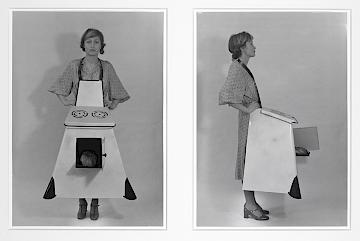 (House wife's kitchen apron) , of 1975, where she carried a stove around her neck, is one of the most remarkable ones. Other pieces, drawings, photos and prints also address a woman's life as a housewife and a spouse. At the same time, other female artists rebelled in their artwork against the prevalent gender roles and ascriptions, and the disparity of everyday life. As for example one could mention the American artist Martha Rosler who made a video performance piece, Semiotics of the kitchen (1975).
(House wife's kitchen apron) , of 1975, where she carried a stove around her neck, is one of the most remarkable ones. Other pieces, drawings, photos and prints also address a woman's life as a housewife and a spouse. At the same time, other female artists rebelled in their artwork against the prevalent gender roles and ascriptions, and the disparity of everyday life. As for example one could mention the American artist Martha Rosler who made a video performance piece, Semiotics of the kitchen (1975).
Women's life as housewives and spouses were portrayed and expressed in depressing and nightmarish pictures by these artists. But this kind of life was common for most of the women in the 70's. It meant a life with low or no education, low or no income, in subordination to the husband, the male spouse. The patriarchal and unequal gender relation was also reflected within the marriage law, which in Austria was enforced in the 1950's and put the male spouse as the leader of the household, able to claim sexual and all other kinds of submission. For this reason, rape for example and other abusive actions within marriage were not accusable, and it was not until the 1980's that the Austrian marriage law was reformed and discrimination and violence within marriage was criminalized and legally banned.
It fits in this picture that the media (journals, magazines, TV) of that time, from the 50's to the 70's and onwards were advocating and transporting images of women as perfect housewives, mothers and spouses, who don't question the husband's decisions, and who strive for these ideals. It was of course these images and representations the feminist artists picked up on and although Birgit Jürgenssen did not particularly broach the marital violence in her work, she did create numerous drawings depicting the life of a lonely housewife, who spent an isolated, dependent, and frustrated life. Along Hausfrauen-Küchenschürze also a number of provocative 'Housewife' drawings, such as Bügeln (z963)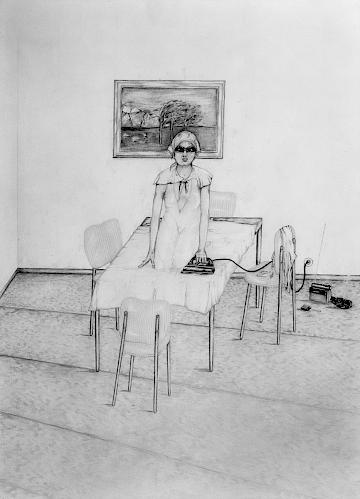 (Ironing) or Bodenschrubben (z402)
(Ironing) or Bodenschrubben (z402)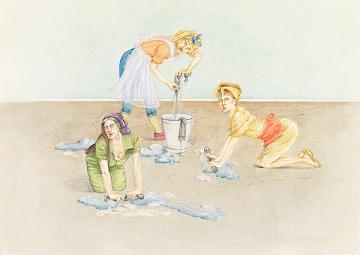 (Floorscrubbing) as well as the photograph 'Ich möchte hier raus' (ph17)
(Floorscrubbing) as well as the photograph 'Ich möchte hier raus' (ph17)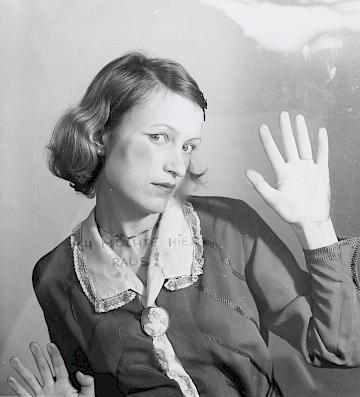 (I Want Out of Here) , of 1976, now famous cover of the book, were created at that time.
(I Want Out of Here) , of 1976, now famous cover of the book, were created at that time.
Other artists of the feminist avant-garde, such as Hannah Wilke, Eleanor Antin and the abovementioned Martha Rosler went even further and were even more radical in their critique on the domestication of women within marriage. With the help of performance, video, installation or photography they protested against a housewife's fate as a cleaning lady, cook and "prostitute" - as a cheap labour and at any times disposal for the husband. Taking into account that these gender conceptions were widespread cultural and normative ideals in European, and Western societies, one understands that women in the 70ies had a hard time in professional and public spheres.
But they were about to emerge and to claim their space. Due to the feminist movements and rebellions of that time in politics, academics as well as in the arts these images and ideals started to crumble, and to breakdown eventually. The artists of the feminist avant-garde were the first to conceptualize art as a political statement in the post-war art world. Unlike other female artists before, who stood out as singular representatives in various art movements, as for example Berthe Morisot within Impressionism, Paula Modersohn-Becker, Kaethe Kollwitz in Expressionism, or Eva Hesse in Modernism, the feminist avant-garde stands in its own right due to its explicit political agenda and critical examination of socio-cultural inequalities and injustices.
Birgit Jürgenssen and the Self: "FRAU" and "I Am"
Another photographic work of 1972 is showing Birgit Jürgenssen on a series of four photos, her body forming the letters "FRAU" (ph1037) . It has been read as an example of Jürgenssen's constructivist approach regarding gender and subject formation. Against the prevalent essentialist canon of the 70ies feminist theory, Jürgenssen depicts gender as a construct of socio-cultural forces. But these forces and constraints are also imprinted into and made visible on the body. Problems of subject formation and identity creation reach deep into philosophical, theoretical spheres, and Jürgenssen's deconstructivist approach was quite ahead of her time. It is remarkable, that artists of the feminist avant-garde, like Jürgenssen herself, did not in particular theorize but yet conceptualized in their artistic work a constructivist/deconstructivist approach that has been theoretically developed much later by the gender-theorists, such as Judith Butler. Butler created in her Gender trouble and Bodies that Matter foundational texts for the newly emerging Gender studies - as a non-essentialist answer to essentialist feminist theory.
. It has been read as an example of Jürgenssen's constructivist approach regarding gender and subject formation. Against the prevalent essentialist canon of the 70ies feminist theory, Jürgenssen depicts gender as a construct of socio-cultural forces. But these forces and constraints are also imprinted into and made visible on the body. Problems of subject formation and identity creation reach deep into philosophical, theoretical spheres, and Jürgenssen's deconstructivist approach was quite ahead of her time. It is remarkable, that artists of the feminist avant-garde, like Jürgenssen herself, did not in particular theorize but yet conceptualized in their artistic work a constructivist/deconstructivist approach that has been theoretically developed much later by the gender-theorists, such as Judith Butler. Butler created in her Gender trouble and Bodies that Matter foundational texts for the newly emerging Gender studies - as a non-essentialist answer to essentialist feminist theory.
Gender studies are committed to a radical deconstruction of gender roles, ideals and norms not just women but also men are subject to. Its analysis lays open the constructive character of society's gender roles and the embodiment of social forces on and in the body, and turns away from essentialist concepts that assumed a male/female essence and natural gender differences between women and men. Gender theory analyses the forces that create power relation and discrimination within society altogether, not just along the axes of gender but on that of race, class, age, sexual and religious orientation as well. Asked the question, if she identified as a feminist artist, Jürgenssen would say: "regarding the awareness raising, analysis and deconstruction of prevalent theories and representational systems - yes". Yet she did not ascribe to an overall, general feminism and was likewise criticized by some (essentialist) feminists. It is likely that Jürgenssen was able to incorporate deconstructivist concepts into her artwork due to her familiarity with poststructuralist philosophy (Foucault, Deleuze), as well as with psychoanalysis (Freud), both sources, also gender theorists referred upon.
Elisabeth Bronfen also picks up the topic of the subject and the 'self' in her contribution "Self-Irony as a autobiographical strategy" where she points out, that Jürgenssen explicitly questioned the idea of a direct, immediate access to one's self. Rather, she says, the self is constituted via complex interplays between inner and outer forces and dynamics, one cannot get rid of, one cannot detach and dissociate from. The I in the other, the other in the I (Wie erfährt man sich im Anderen, das Andere in sich) was the title of Jürgenssen's exhibition at the Gallery Hubert Winter in 1985. Therein she reflected the gaze of the other upon oneself, and how it affects one's own identity construction. Is a genuine self-creation in a male dominated society possible at all? Jürgenssen's artistic strategy to face this was an ironic play of experiments of self-analysis, abundantly shown in her photo series and graphic work. She does not re/claim a female virility, but ridicules the concept of virility and male supremacy altogether. In an interview with Felicitas Thun-Hohenstein she stated that she uses self-irony as a strategy to mediate subversive and deconstructive potentials. It was never her intention to search for a genuine female identity, but to question and overcome constructive mechanisms of identity formation altogether. „The person is a product of combinatorics, more or less stable", she said in another interview. This is a statement gender-theorists can only sign into. But the possibility of self-realization, of choosing one's own "combinatorics" is possible only where gender and other social constraints do not bind any longer.
Embedded in these broader topics of women, gender and identity, the 'Artistic Self' is another leitmotif in Jürgenssen's work and explorative journeys. Within the arts women appeared as objects most of the time, as models and muses for male artists, they were seen through their projections but hardly recognized as artists in their own right. Jürgenssen's art making refuses these objectifications and claims recognition for a woman as an artistic subject.
"I Am" (s46)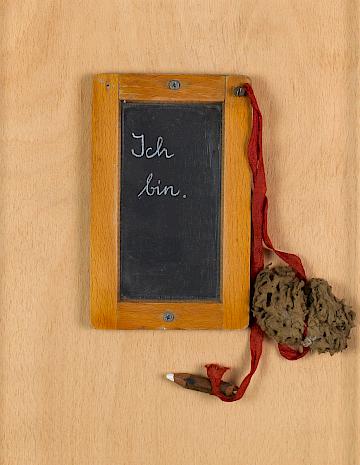 of 1995, written on blackboard, with white charcoal and a sponge on the side can be seen as an allusion for self creation, self writing, but also of over-writing and erasion. The two words "I Am", on a school's blackboard, form a statement, a declaration, but one, that can be erased with the sponge any time. This declaration is a rather fragile one - it's written with dusty white chalk but not engraved in stone, for eternity. Jürgenssen employs great metaphoric power here. Gabriele Schor also traces the complex relations between society, gender, and the I within Jürgenssen's work in her contribution "I Am" and the Flux of the Artistic Self. There Schor particularly elaborates the question why over the course of the years, a woman's face gradually vanishes in Jürgenssen's work and is replaced by an animal's head and other masks. Is there an 'animalistic turn' here to see? What does the hiding behind a mask, the disappearance of the face tell us? Jürgenssen commented very rarely on her work, but the topoi of the mask can be seen as a metaphor for transformation, disappearance but also of retreat and hiding. Schor discusses the dialectics between the presence and absence of the artistic self and observes three stages in Birgit Jürgenssens's artistic progress and self-appropriation: those of protest, transformation, and self-affirmation. Maybe even a fourth stage of self-disaggregation and disintegration could be added.
of 1995, written on blackboard, with white charcoal and a sponge on the side can be seen as an allusion for self creation, self writing, but also of over-writing and erasion. The two words "I Am", on a school's blackboard, form a statement, a declaration, but one, that can be erased with the sponge any time. This declaration is a rather fragile one - it's written with dusty white chalk but not engraved in stone, for eternity. Jürgenssen employs great metaphoric power here. Gabriele Schor also traces the complex relations between society, gender, and the I within Jürgenssen's work in her contribution "I Am" and the Flux of the Artistic Self. There Schor particularly elaborates the question why over the course of the years, a woman's face gradually vanishes in Jürgenssen's work and is replaced by an animal's head and other masks. Is there an 'animalistic turn' here to see? What does the hiding behind a mask, the disappearance of the face tell us? Jürgenssen commented very rarely on her work, but the topoi of the mask can be seen as a metaphor for transformation, disappearance but also of retreat and hiding. Schor discusses the dialectics between the presence and absence of the artistic self and observes three stages in Birgit Jürgenssens's artistic progress and self-appropriation: those of protest, transformation, and self-affirmation. Maybe even a fourth stage of self-disaggregation and disintegration could be added.
„Pulse beat of a Sensuality"
Jürgenssen's education in a French Elementary School, her visit to Paris at age seventeen and encounters with surrealism, notably with surrealistic poetry and literature, deeply influenced her processes of art making. Taking into account also the inputs from the abovementioned philosophies of deconstruction, post-structuralism and psychoanalysis, Jürgenssen had all the ingredients together for a fascinating interplay between real world and imaginary spaces. Another characteristic feature is her occupation with language that she employs extensively in her art. Jürgenssen developed her artistic ideas, vocabulary and styles in dialogue with her expanding intellectual influences and inspirations in the notebooks where she interweaved wordplays, poems, and rhymes, citations from philosophy and literature texts into intelligent, ironic, metaphoric and surreal collages. Schor describes these characteristics of Jürgenssens work as hybrid, nomadic and intertextual in her introductory chapter of the essay „On the Pulse beat of a Sensuality". In fact, the Jürgenssens intellectual and aesthetic ways of exploring any theme intensely, her desire to experiment, analyze and deconstruct are signature features of her artistic practice. Easily she moves and circulates between diverse media, such as drawing, photography, printmaking, lithography, watercolor, sculpture and collage.
Jürgenssen used a heterogenous variety of graphic media as modes of thought and thematic development. What she did not do was painting - large or small scale painting in oils. As Irmeli Hautamäki points out in her comment, the feminist avant-garde artists rejected painting as a medium, since it was celebrated in the male dominated art world, and chose photography, performance, and video as means of expression instead. In the 60's and 70's large scale paintings, as in American Abstract Expressionism, with aesthetic questions of space and representation were prevalent in the arts. As a counter-reaction women artists replaced these painterly and male/macho traditions with new experimental, explorative and investigative modes of art practices, using all kinds of media. Last I'd like to mention briefly two outstanding work cycles Jürgenssen got famous for: Body projections (Körperprojektionen, 1988) and Schuhwerk. In Body projections she employed her naked belly as a surface to project images and signs on (ph48) . Her navel in the middle is like a focal point, catching the eye of the viewer. Similar to the erasable "I Am" on the blackboard, the projections are inscriptions on the body but do not mark or engrave the body; the projections on the belly's surface disappear any time, when the light of the projector is turned off. What is charming to me is, that Birgit Jürgenssen always remains sexually hidden and, unlike her peer artists of that time, namely the Vienna Actionists, never exposes her body, her genitals, not even her breasts and nipples. Although she gets quite sexually graphic in some of her drawings, in her photography she never does so.
. Her navel in the middle is like a focal point, catching the eye of the viewer. Similar to the erasable "I Am" on the blackboard, the projections are inscriptions on the body but do not mark or engrave the body; the projections on the belly's surface disappear any time, when the light of the projector is turned off. What is charming to me is, that Birgit Jürgenssen always remains sexually hidden and, unlike her peer artists of that time, namely the Vienna Actionists, never exposes her body, her genitals, not even her breasts and nipples. Although she gets quite sexually graphic in some of her drawings, in her photography she never does so.
"Schuhwerk" is a cycle Solomon-Godeau discusses in her chapter "If the Shoe Fits" . Schuhwerk is a cycle of shoe sculptures, in all kinds of names and variations (pregnant shoe (s7) , raven shoe (s9)
, raven shoe (s9) , etc.), a very ironic example of the shoe fetishism (that she was herself obsessed with). Other chapters in the monograph include Sigrid Schade's "The Corpes Lives" - Pictoral Tradition and Gender Construction, and Geraldine Spiekermann's "What She Saw in the Water" , a discussion of Jürgenssen's Bath Polaroid Series (Blue Bath, Red Bath, Black Bath).
, etc.), a very ironic example of the shoe fetishism (that she was herself obsessed with). Other chapters in the monograph include Sigrid Schade's "The Corpes Lives" - Pictoral Tradition and Gender Construction, and Geraldine Spiekermann's "What She Saw in the Water" , a discussion of Jürgenssen's Bath Polaroid Series (Blue Bath, Red Bath, Black Bath).
Summary
Undoubtedly, with this monograph a remarkable Austrian artist is discovered. Peter Weibel called Birgit Jürgenssen the 'missing link' in art history between Austrian and international feminist avant-garde and placed her in line with Meret Oppenheim, Louise Bourgeois, and contemporary Cindy Sherman. As already mentioned in the beginning, this recognition did not come in her lifetime. But artist's like her have paved the way for the later, self-conscious female artist generation to come in the so called 'post-feminist' time of the late 20th century until present. The reception and refurbishment of her artistic legacy is only at the beginning. Her work has been recently shown at the Sammlung Verbund Gallery Vienna and at the DONNA exhibition in Rome early this year. It will be brought to a broader public eye with the first personal exhibition at the Kunstforum Vienna that opens December 16th. Curated by Gabriele Schor and Heike Eipeldauer, this posthumous retrospective will redeem the long overdue recognition of this exceptional artist, who has now been discovered as a true jewel in the family of feminist avant-garde.